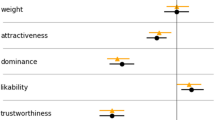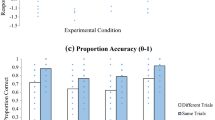Abstract
Male and female subjects described nine photographs that had been selected to be of interest to males, females, or both. The resulting speech samples were analyzed for the incidence of five features of word production and five features associated with a “women's language” (WL) speech style. Results showed that topic (photograph type) determined aspects of speech production. However, there were no gender differences in production or style. Correlations between dependent variables suggested that WL is a consistent set of features. Its use by both female and male speakers may reflect social uncertainty.
Similar content being viewed by others
References
Argyle, M., Lalljee, M., & Cook, M. (1968). The effects of visibility on interaction in a dyad.Human Relations, 21, 3–17.
Aries, E. J. (1976). Interaction patterns and themes of male, female, and mixed groups.Small Group Behavior, 7, 7–18.
Crosby, F., & Nyquist, L. (1977). The female register: An empirical study of Lakoff's hypothesis.Language in Society, 6, 313–322.
Gall, M. D., Hobby, A. K., & Craik, K. (1969). Nonlinguistic factors in oral language productivity.Perceptual and Motor Skills, 29, 871–874.
Haas, A. (1979). Male and female spoken language differences: Stereotypes and evidence.Psychological Bulletin, 86, 616–626.
Jordan, W. J., & Powers, W. G. (1978). Verbal behavior as a function of apprehension and social context.Human Communication Research, 4, 294–300.
Lakoff, R. (1973). Language and women's place.Language in Society, 2, 45–80.
Liska, J., Mechling, E. W., & Stathas, S. (1981). Differences in subjects' perceptions of gender and believability between users of deferential and non-deferential language.Communication Quarterly, 29, 40–48.
McMillan, J. R., Clifton, A. K., McGrath, D., & Gale, W. S. (1977). women's language: Uncertainty or interpersonal sensitivity and emotionality?Sex Roles, 3, 545–559.
O'Barr, W. M., & Atkins, B. K. (1980). “Women's language” or “powerless language”? In S. McConnell-Ginet, N. Borker, & R. Thurman (Eds.),Women and language in literature and society. New York: Praeger.
Powers, W. C. (1977). The rhetorical interrogative: Anxiety or control?Human Communication Research, 4, 44–47.
Rubin, D. L., & Nelson, M. W. (1983). Multiple determinants of a stigmatized speech style: Women's language, powerless language, or everyone's language?Language and Speech, 26, 273–290.
Sayers, F. (1984, June 28).Interaction involvement, gender role, and selected conversational behaviors. Paper presented at the National Women's Studies Association, Douglass College, New Brunswick, New Jersey.
Smith, P. M. (1979). Sex markers in speech. In K. P. Scherer & H. Giles (Eds.),Social markers in speech. Cambridge: Cambridge University Press.
Spender, D. (1980).Man made language. London: Routledge & Kegan Paul.
Swacker, M. (1975) The sex of the speaker as a sociolinguistic variable. In B. Thorne & N. Henley (Eds.),Language and sex: Difference and dominance. Rowley, Massachusetts: Newbury.
Wood, M. (1966). The influence of sex and knowledge of communication effectiveness on spontaneous speech.Word, 22, 112–137.
Author information
Authors and Affiliations
Additional information
The authors thank Janis Glenn and Cynthia Johnson for help in collecting and transcribing data.
Rights and permissions
About this article
Cite this article
Crawford, M., Chaffin, R. Effects of gender and topic on speech style. J Psycholinguist Res 16, 83–89 (1987). https://doi.org/10.1007/BF01067752
Accepted:
Issue Date:
DOI: https://doi.org/10.1007/BF01067752




